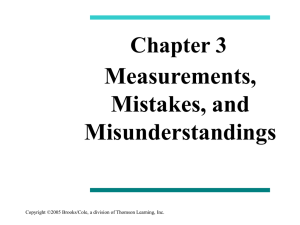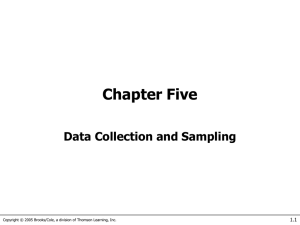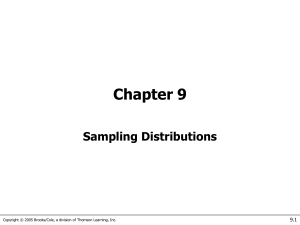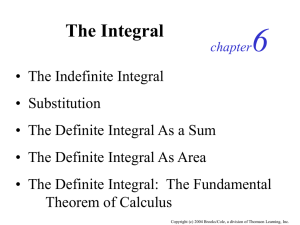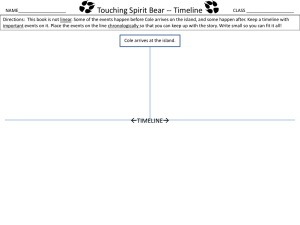Checking Assumptions
advertisement
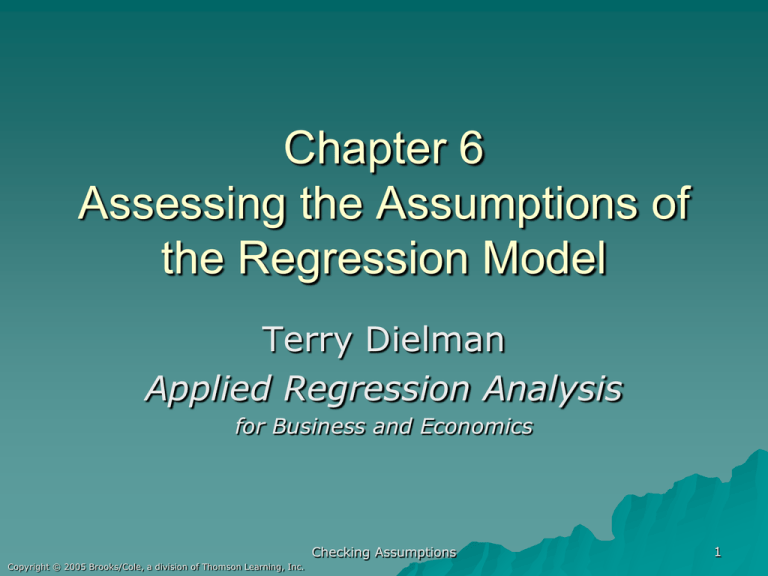
Chapter 6 Assessing the Assumptions of the Regression Model Terry Dielman Applied Regression Analysis for Business and Economics Checking Assumptions Copyright © 2005 Brooks/Cole, a division of Thomson Learning, Inc. 1 6.1 Introduction In Chapter 4 the multiple linear regression model was presented as yi 0 1 x1i 2 x2i k xki ei Certain assumptions were made about how the errors ei behaved. In this chapter we will check to see if those assumptions appear reasonable. Checking Assumptions Copyright © 2005 Brooks/Cole, a division of Thomson Learning, Inc. 2 6.2 Assumptions of the Multiple Linear Regression Model a. b. c. d. We expect the average disturbance ei to be zero so the regression line passes through the average value of Y. The disturbances have constant variance e2. The disturbances are normally distributed. The disturbances are independent. Checking Assumptions Copyright © 2005 Brooks/Cole, a division of Thomson Learning, Inc. 3 6.3 The Regression Residuals We cannot check to see if the disturbances ei behave correctly because they are unknown. Instead, we work with their sample counterpart, the residuals eˆi yi yˆi which represent the unexplained variation in the y values. Checking Assumptions Copyright © 2005 Brooks/Cole, a division of Thomson Learning, Inc. 4 Properties Property 1: They will always average 0 because the least squares estimation procedure makes that happen. Property 2: If assumptions a, b and d of Section 6.2 are true then the residuals should be randomly distributed around their mean of 0. There should be no systematic pattern in a residual plot. Property 3: If assumptions a through d hold, the residuals should look like a random sample from a normal distribution. Checking Assumptions Copyright © 2005 Brooks/Cole, a division of Thomson Learning, Inc. 5 Suggested Residual Plots Plot the residuals versus each explanatory variable. 2. Plot the residuals versus the predicted values. 3. For data collected over time or in any other sequence, plot the residuals in that sequence. In addition, a histogram and box plot are useful for assessing normality. 1. Checking Assumptions Copyright © 2005 Brooks/Cole, a division of Thomson Learning, Inc. 6 Standardized residuals The residuals can be standardized by dividing by their standard error. This will not change the pattern in a plot but will affect the vertical scale. Standardized residuals are always scaled so that most are between -2 and +2 as in a standard normal distribution. Checking Assumptions Copyright © 2005 Brooks/Cole, a division of Thomson Learning, Inc. 7 A plot meeting property 2 a. mean of 0 b. Same scatter d. No pattern with X 3 2 Res 1 0 -1 -2 95 100 105 110 X Checking Assumptions Copyright © 2005 Brooks/Cole, a division of Thomson Learning, Inc. 8 A plot showing a violation Checking Assumptions Copyright © 2005 Brooks/Cole, a division of Thomson Learning, Inc. 9 6.4 Checking Linearity Although sometimes we can see evidence of nonlinearity in an X-Y scatterplot, in other cases we can only see it in a plot of the residuals versus X. If the plot of the residuals versus an X shows any kind of pattern, it both shows a violation and a way to improve the model. Checking Assumptions Copyright © 2005 Brooks/Cole, a division of Thomson Learning, Inc. 10 Example 6.1: Telemarketing n = 20 telemarketing employees Y = average calls per day over 20 workdays X = Months on the job Data set TELEMARKET6 Checking Assumptions Copyright © 2005 Brooks/Cole, a division of Thomson Learning, Inc. 11 Plot of Calls versus Months 35 CALLS 30 There is some curvature, but it is masked by the more obvious linearity. 25 20 10 20 30 MONTHS Checking Assumptions Copyright © 2005 Brooks/Cole, a division of Thomson Learning, Inc. 12 If you are not sure, fit the linear model and save the residuals The regression equation is CALLS = 13.7 + 0.744 MONTHS Predictor Constant MONTHS S = 1.787 Coef 13.671 0.74351 SE Coef 1.427 0.06666 R-Sq = 87.4% T 9.58 11.15 P 0.000 0.000 R-Sq(adj) = 86.7% Analysis of Variance Source Regression Residual Error Total DF 1 18 19 SS 397.45 57.50 454.95 MS 397.45 3.19 Checking Assumptions Copyright © 2005 Brooks/Cole, a division of Thomson Learning, Inc. F 124.41 P 0.000 13 Residuals from model With the linearity "taken out" the curvature is more obvious Checking Assumptions Copyright © 2005 Brooks/Cole, a division of Thomson Learning, Inc. 14 6.4.2 Tests for lack of fit The residuals contain the variation in the sample of Y values that is not explained by the Yhat equation. This variation can be attributed to many things, including: • natural variation (random error) • omitted explanatory variables • incorrect form of model Checking Assumptions Copyright © 2005 Brooks/Cole, a division of Thomson Learning, Inc. 15 Lack of fit If nonlinearity is suspected, there are tests available for lack of fit. Minitab has two versions of this test, one requiring there to be repeated observations at the same X values. These are on the Options submenu off the Regression menu Checking Assumptions Copyright © 2005 Brooks/Cole, a division of Thomson Learning, Inc. 16 The pure error lack of fit test In the 20 observations for the telemarketing data, there are two at 10, 20 and 22 months, and four at 25 months. These replicates allow the SSE to be decomposed into two portions, "pure error" and "lack of fit". Checking Assumptions Copyright © 2005 Brooks/Cole, a division of Thomson Learning, Inc. 17 The test H0: The relationship is linear Ha: The relationship is not linear The test statistic follows an F distribution with c – k – 1 numerator df and n – c denominator df c = number of distinct levels of X n = 20 and there were 6 replicates so c = 14 Checking Assumptions Copyright © 2005 Brooks/Cole, a division of Thomson Learning, Inc. 18 Minitab's output The regression equation is CALLS = 13.7 + 0.744 MONTHS Predictor Constant MONTHS S = 1.787 Coef 13.671 0.74351 SE Coef 1.427 0.06666 R-Sq = 87.4% T 9.58 11.15 P 0.000 0.000 R-Sq(adj) = 86.7% Analysis of Variance Source Regression Residual Error Lack of Fit Pure Error Total DF 1 18 12 6 19 SS 397.45 57.50 52.50 5.00 454.95 MS 397.45 3.19 4.38 0.83 Checking Assumptions Copyright © 2005 Brooks/Cole, a division of Thomson Learning, Inc. F 124.41 P 0.000 5.25 0.026 19 Test results At a 5% level of significance, the critical value (from F12, 6 distribution) is 4.00. The computed F is 5.25 is significant (p value of .026) so we conclude the relationship is not linear. Checking Assumptions Copyright © 2005 Brooks/Cole, a division of Thomson Learning, Inc. 20 Tests without replication Minitab also has a series of lack of fit tests that can be applied when there is no replication. When they are applied here, these messages appear: Lack of fit test Possible curvature in variable MONTHS (P-Value = 0.000) Possible lack of fit at outer X-values (P-Value = 0.097) Overall lack of fit test is significant at P = 0.000 The small p values suggest lack of fit. Checking Assumptions Copyright © 2005 Brooks/Cole, a division of Thomson Learning, Inc. 21 6.4.3 Corrections for nonlinearity If the linearity assumption is violated, the appropriate correction is not always obvious. Several alternative models were presented in Chapter 5. In this case, it is not too hard to see that adding an X2 term works well. Checking Assumptions Copyright © 2005 Brooks/Cole, a division of Thomson Learning, Inc. 22 Quadratic model The regression equation is CALLS = - 0.14 + 2.31 MONTHS - 0.0401 MonthSQ Predictor Constant MONTHS MonthSQ Coef -0.140 2.3102 -0.040118 S = 1.003 SE Coef 2.323 0.2501 0.006333 R-Sq = 96.2% T -0.06 9.24 -6.33 P 0.952 0.000 0.000 R-Sq(adj) = 95.8% Analysis of Variance Source Regression Residual Error Total DF 2 17 19 SS 437.84 17.11 454.95 MS 218.92 1.01 F 217.50 P 0.000 No evidence of lack of fit (P > 0.1) Checking Assumptions Copyright © 2005 Brooks/Cole, a division of Thomson Learning, Inc. 23 Residuals from quadratic model RESI1 1 0 -1 10 No violations evident 20 MONTHS Checking Assumptions Copyright © 2005 Brooks/Cole, a division of Thomson Learning, Inc. 30 24 6.5 Check for constant variance Assumption b states that the errors ei should have the same variance everywhere. This implies that if residuals are plotted against an explanatory variable, the scatter should be the same at each value of the X variable. In economic data, however, it is fairly common to see that a variable that increases in value often will also increase in scatter. Checking Assumptions Copyright © 2005 Brooks/Cole, a division of Thomson Learning, Inc. 25 Example 6.3 FOC Sales n = 265 months of sales data for a fibre-optic company Y = Sales X= Mon ( 1 thru 265) Data set FOCSALES6 Checking Assumptions Copyright © 2005 Brooks/Cole, a division of Thomson Learning, Inc. 26 Data over time Note: This uses Minitab’s Time Series Plot 40000 SALES 30000 20000 10000 0 Index 100 Checking Assumptions Copyright © 2005 Brooks/Cole, a division of Thomson Learning, Inc. 200 27 Residual plot Checking Assumptions Copyright © 2005 Brooks/Cole, a division of Thomson Learning, Inc. 28 Implications When the errors ei do not have a constant variance, the usual statistical properties of the least squares estimates may not hold. In particular, the hypothesis tests on the model may provide misleading results. Checking Assumptions Copyright © 2005 Brooks/Cole, a division of Thomson Learning, Inc. 29 6.5.2 A Test for Nonconstant Variance Szroeter developed a test that can be applied if the observations appear to increase in variance according to some sequence (often, over time). To perform it, save the residuals, square them, then multiply by i (the observation number). Details are in the text. Checking Assumptions Copyright © 2005 Brooks/Cole, a division of Thomson Learning, Inc. 30 6.5.3 Corrections for Nonconstant Variance Several common approaches for correcting nonconstant variance are: 1. Use ln(y) instead of y 2. Use √y instead of y 3. Use some other power of y, yp, where the Box-Cox method is used to determine the value for p. 4. Regress (y/x) on (1/x) Checking Assumptions Copyright © 2005 Brooks/Cole, a division of Thomson Learning, Inc. 31 LogSales over time LogSales 10 9 8 Index 100 Checking Assumptions Copyright © 2005 Brooks/Cole, a division of Thomson Learning, Inc. 200 32 Residuals from Regression This looks real good after I put this text box on top of those six large outliers. Checking Assumptions Copyright © 2005 Brooks/Cole, a division of Thomson Learning, Inc. 33 6.6 Assessing the Assumption That the Disturbances are Normally Distributed There are many tools available to check the assumption that the disturbances are normally distributed. If the assumption holds, the standardized residuals should behave like they came from a standard normal distribution. – – – about 68% between -1 and +1 about 95% between -2 and +2 about 99% between -3 and +3 Checking Assumptions Copyright © 2005 Brooks/Cole, a division of Thomson Learning, Inc. 34 6.6.1 Using Plots to Assess Normality You can plot the standardized residuals versus fitted values and count how many are beyond -2 and +2; about 1 in 20 would be the usual case. Minitab will do this for you if ask it to check for unusual observations (those flagged by an R have a standardized residual beyond ±2. Checking Assumptions Copyright © 2005 Brooks/Cole, a division of Thomson Learning, Inc. 35 Other tools Use a Normal Probability plot to test for normality. Use a histogram (perhaps with a superimposed normal curve) to look at shape. Use a Boxplot for outlier detection. It will show all outliers with an *. Checking Assumptions Copyright © 2005 Brooks/Cole, a division of Thomson Learning, Inc. 36 Example 6.5 Communication Nodes Data in COMNODE6 n = 14 communication networks Y = Cost X1 = Number of ports X2 = Bandwidth Checking Assumptions Copyright © 2005 Brooks/Cole, a division of Thomson Learning, Inc. 37 Regression with unusuals flagged The regression equation is COST = 17086 + 469 NUMPORTS + 81.1 BANDWIDTH Predictor Constant NUMPORTS BANDWIDT S = 2983 Coef 17086 469.03 81.07 SE Coef 1865 66.98 21.65 R-Sq = 95.0% T 9.16 7.00 3.74 P 0.000 0.000 0.003 R-Sq(adj) = 94.1% Analysis of Variance (deleted) Unusual Observations Obs NUMPORTS COST 1 68.0 52388 10 24.0 23444 Fit 53682 29153 SE Fit 2532 1273 Residual -1294 -5709 St Resid -0.82 X -2.12R R denotes an observation with a large standardized residual X denotes an observation whose X value gives it large influence. Checking Assumptions Copyright © 2005 Brooks/Cole, a division of Thomson Learning, Inc. 38 Residuals versus fits (from regression graphs) Checking Assumptions Copyright © 2005 Brooks/Cole, a division of Thomson Learning, Inc. 39 6.6.2 Tests for normality There are several formal tests for the hypothesis that the disturbances ei are normal versus nonnormal. These are often accompanied by graphs* which are scaled so that data which are normally-distributed appear in a straight line. * Your Minitab output may appear a little different depending on whether you have the student or professional version, and which release you have. Checking Assumptions Copyright © 2005 Brooks/Cole, a division of Thomson Learning, Inc. 40 Normal plot (from regression graphs) Normal Probability Plot of the Residuals (response is COST) 2 Normal Score 1 If normal, should follow straight line 0 -1 -2 -2 -1 0 1 Standardized Residual Checking Assumptions Copyright © 2005 Brooks/Cole, a division of Thomson Learning, Inc. 41 Normal probability plot (graph menu) Checking Assumptions Copyright © 2005 Brooks/Cole, a division of Thomson Learning, Inc. 42 Test for Normality (Basic Statistics Menu) Accepts Ho: Normality Checking Assumptions Copyright © 2005 Brooks/Cole, a division of Thomson Learning, Inc. 43 Part 2 Checking Assumptions Copyright © 2005 Brooks/Cole, a division of Thomson Learning, Inc. 44 Example 6.7 S&L Rate of Return Data set SL6 n =35 Saving and Loans stocks Y = rate of return for 5 years ending 1982 X1 = the "Beta" of the stock X2 = the "Sigma" of the stock Beta is a measure of nondiversifiable risk and Sigma a measure of total risk Checking Assumptions Copyright © 2005 Brooks/Cole, a division of Thomson Learning, Inc. 45 10 RETURN Basic exploration 5 0 0 10 20 SIGMA Correlations: RETURN, BETA, SIGMA RETURN 10 RETURN 5 0 0.5 1.5 BETA 0.180 SIGMA 0.351 BETA 0.406 2.5 BETA Checking Assumptions Copyright © 2005 Brooks/Cole, a division of Thomson Learning, Inc. 46 Not much explanatory power The regression equation is RETURN = - 1.33 + 0.30 BETA + 0.231 SIGMA Predictor Constant BETA SIGMA S = 2.377 Coef -1.330 0.300 0.2307 SE Coef 2.012 1.198 0.1255 R-Sq = 12.5% T -0.66 0.25 1.84 P 0.513 0.804 0.075 R-Sq(adj) = 7.0% Analysis of Variance (deleted) Unusual Observations Obs BETA RETURN 19 2.22 0.300 29 1.30 13.050 Fit -0.231 2.130 SE Fit 2.078 0.474 Residual 0.531 10.920 St Resid 0.46 X 4.69R R denotes an observation with a large standardized residual X denotes an observation whose X value gives it large influence. Checking Assumptions Copyright © 2005 Brooks/Cole, a division of Thomson Learning, Inc. 47 One in every crowd? Checking Assumptions Copyright © 2005 Brooks/Cole, a division of Thomson Learning, Inc. 48 Normality Test Reject H0: Normality Checking Assumptions Copyright © 2005 Brooks/Cole, a division of Thomson Learning, Inc. 49 6.6.3 Corrections for Nonnormality Normality is not necessary for making inference with large samples. It is required for inference with small samples. The remedies are similar to those used to correct for nonconstant variance. Checking Assumptions Copyright © 2005 Brooks/Cole, a division of Thomson Learning, Inc. 50 6.7 Influential Observations In minimizing SSE, the least squares procedure tries to avoid large residuals. It thus "pays a lot of attention" to y values that don't fit the usual pattern in the data. Refer to the example in Figures 6.42(a) and 6.42(b). That probably also happened in the S&L data where the one very high return masked the relationship between rate of return, beta and sigma for the other 34 stocks. Checking Assumptions Copyright © 2005 Brooks/Cole, a division of Thomson Learning, Inc. 51 6.7.2 Identifying outliers Minitab flags any residual bigger than 2 in absolute value as a potential outlier. A boxplot of the residuals uses a slightly different rule, but should give similar results. There is also a third type of residual that is often used for this purpose. Checking Assumptions Copyright © 2005 Brooks/Cole, a division of Thomson Learning, Inc. 52 Deleted residuals If you (temporarily) eliminate the ith observation from the data set, it cannot influence the estimation process. You can then compute a "deleted" residual to see if this point fits the pattern in the other observations. Checking Assumptions Copyright © 2005 Brooks/Cole, a division of Thomson Learning, Inc. 53 Deleted Residual Illustration The regression equation is ReturnWO29 = - 2.51 + 0.846 BETA + 0.232 SIGMA 34 cases used 1 cases contain missing values Predictor Constant BETA SIGMA S = 1.352 Coef -2.510 0.8463 0.23220 SE Coef 1.153 0.6843 0.07135 R-Sq = 37.2% T -2.18 1.24 3.25 P 0.037 0.225 0.003 R-Sq(adj) = 33.1% Without observation 29, we get a much better fit. Predicted Y29 = -2.51 + .846(1.2973) + .232(13.3110) = 1.678 Prediction SE is 1.379 Deleted residual29 = (13.05 – 1.678)/1.379 = 8.24 Checking Assumptions Copyright © 2005 Brooks/Cole, a division of Thomson Learning, Inc. 54 The influence of observation 29 When it was temporarily the R2 went from 12.5% removed, to 37.2% and we got a very different equation The deleted residual for this observation was a whopping 8.24, which shows it had a lot of weight in determining the original equation. Checking Assumptions Copyright © 2005 Brooks/Cole, a division of Thomson Learning, Inc. 55 6.7.3 Identifying Leverage Points Outliers have unusual y values; data points with unusual X values are said to have leverage. Minitab flags these with an X. These points can have a lot of influence in determining the Yhat equation, particularly if they don't fit well. Minitab would flag these with both an R and an X. Checking Assumptions Copyright © 2005 Brooks/Cole, a division of Thomson Learning, Inc. 56 Leverage The leverage of the ith observation is hi (it is hard to show where this comes from without matrix algebra). If h > 2(K+1)/n it has high leverage. For S&P returns, k = 2 and n = 35 so the benchmark is 2(3)/35 = .171 Observation 19 has a very small value for Sigma, this is the reason why it has h19 = .764 Checking Assumptions Copyright © 2005 Brooks/Cole, a division of Thomson Learning, Inc. 57 6.7.4 Combined Measures The effect of an observation on the regression line is a function of both the y and X values. Several statistics have been developed that attempt to measure combined influence. The DFIT statistic and Cook's D are two more-popular measures. Checking Assumptions Copyright © 2005 Brooks/Cole, a division of Thomson Learning, Inc. 58 The DFIT statistic The DFIT statistic is a function of both the residual and the leverage. Minitab can compute and save these under "Storage". Sometimes a cutoff is used, but it is perhaps best just to look for values that are high. Checking Assumptions Copyright © 2005 Brooks/Cole, a division of Thomson Learning, Inc. 59 DFIT Graphed 29 1.5 DFIT1 1.0 19 0.5 0.0 0 5 10 15 20 25 30 35 Observation Number Checking Assumptions Copyright © 2005 Brooks/Cole, a division of Thomson Learning, Inc. 60 Cook's D Often called Cook's Distance Minitab also will compute these and store them. Again, it might be best just to look for high values rather than use a cutoff. Checking Assumptions Copyright © 2005 Brooks/Cole, a division of Thomson Learning, Inc. 61 Cook's D Graphed 29 0.3 19 COOK1 0.2 0.1 0.0 0 5 10 15 20 25 30 35 Observation Number Checking Assumptions Copyright © 2005 Brooks/Cole, a division of Thomson Learning, Inc. 62 6.7.5 What to do with Unusual Observations Observation 19 (First Lincoln Financial Bank) has high influence because of its very low Sigma. Observation 29 (Mercury Saving) had a very high return of 13.05 but its Beta and Sigma were not unusual. Since both values are out of line with the other S&L banks, they may represent data recording errors. Checking Assumptions Copyright © 2005 Brooks/Cole, a division of Thomson Learning, Inc. 63 Eliminate? Adjust? If you can do further research you might find out the true story. You should eliminate an outlier data point only when you are convinced it does not belong with the others (for example, if Mercury was speculating wildly). An alternative is to keep the data point but add an indicator variable to the model that signals there is something unusual about this observation. Checking Assumptions Copyright © 2005 Brooks/Cole, a division of Thomson Learning, Inc. 64 6.8 Assessing the Assumption That the Disturbances are Independent If the disturbances are independent, the residuals should not display any patterns. One such pattern was the curvature in the residuals from the linear model in the telemarketing example. Another pattern occurs frequently in data collected over time. Checking Assumptions Copyright © 2005 Brooks/Cole, a division of Thomson Learning, Inc. 65 6.8.1 Autocorrelation In time series data we often find that the disturbances tend to stay at the same level over consecutive observations. If this feature, called autocorrelation, is present, all our model inferences may be misleading. Checking Assumptions Copyright © 2005 Brooks/Cole, a division of Thomson Learning, Inc. 66 First-order autocorrelation If the disturbances have first-order autocorrelation, they behave as: ei = ei-1 + µi where µi is a disturbance with expected value 0 and independent over time. Checking Assumptions Copyright © 2005 Brooks/Cole, a division of Thomson Learning, Inc. 67 The effect of autocorrelation If you knew that e56 was 10 and was .7, you would expect e57 to be 7 instead of zero. This dependence can lead to high standard errors for the bj coefficients and wider confidence intervals. Checking Assumptions Copyright © 2005 Brooks/Cole, a division of Thomson Learning, Inc. 68 6.8.2 A Test for First-Order Autocorrelation Durbin and Watson developed a test for positive autocorrelation of the form: H0: = 0 H a: > 0 Their test statistic d is scaled so that it is 2 if no autocorrelation is present and near 0 if it is very strong. Checking Assumptions Copyright © 2005 Brooks/Cole, a division of Thomson Learning, Inc. 69 A Three-Part Decision Rule The Durbin-Watson test distribution depends on n and K. The tables (Table B.7) list two decision points dL and dU. If d < dL reject H0 and conclude there is positive autocorrelation. If d > dU accept H0 and conclude there is no autocorrelation. If dL d dU the test is inconclusive. Checking Assumptions Copyright © 2005 Brooks/Cole, a division of Thomson Learning, Inc. 70 Example 6.10 Sales and Advertising n = 36 years of annual data Y = Sales (in million $) X = Advertising expenditures ($1000s) Data in Table 6.6 Checking Assumptions Copyright © 2005 Brooks/Cole, a division of Thomson Learning, Inc. 71 The Test n = 36 and K = 1 X-variable At a 5% level of significance, Table B.7 gives dL = 1.41 and dU = 1.52 Decision Rule: Reject H0 if d < 1.41 Accept H0 if d > 1.52 Inconclusive if 1.41 d 1.52 Checking Assumptions Copyright © 2005 Brooks/Cole, a division of Thomson Learning, Inc. 72 Regression With DW Statistic The regression equation is Sales = - 633 + 0.177 Adv Predictor Constant Adv Coef -632.69 0.177233 S = 36.49 SE Coef 47.28 0.007045 R-Sq = 94.9% T -13.38 25.16 P 0.000 0.000 R-Sq(adj) = 94.8% Analysis of Variance Source Regression Residual Error Total DF 1 34 35 SS 842685 45277 887961 Unusual Observations Obs Adv Sales 1 5317 381.00 15 6272 376.10 Fit 309.62 478.86 MS 842685 1332 F 632.81 SE Fit 11.22 6.65 P 0.000 Residual 71.38 -102.76 St Resid 2.06R -2.86R R denotes an observation with a large standardized residual Durbin-Watson statistic = 0.47 Significant autocorrelation Checking Assumptions Copyright © 2005 Brooks/Cole, a division of Thomson Learning, Inc. 73 Plot of Residuals over Time 2 SRES1 1 0 -1 Shows first-order autocorrelation with r = .71 -2 -3 Index 10 20 Checking Assumptions Copyright © 2005 Brooks/Cole, a division of Thomson Learning, Inc. 30 74 6.8.3 Correction for First-Order Autocorrelation One popular approach creates a new y and x variable. First, obtain an estimate of . Here we use r = .71 from Minitab's Autocorrelation analysis. Then compute yi* = yi – r yi-1 and xi* = xi – r xi-1 Checking Assumptions Copyright © 2005 Brooks/Cole, a division of Thomson Learning, Inc. 75 First Observation Missing Because the transformation depends on lagged y and x values, the first observation requires special handling. The text suggests y1* = √1 – r2 y1 and a similar computation for x1* Checking Assumptions Copyright © 2005 Brooks/Cole, a division of Thomson Learning, Inc. 76 Other Approaches An alternative is to use an estimation technique (such as SAS's Autoreg procedure) that automatically adjusts for autocorrelation. A third option is to include a lagged value of y as an explanatory variable. In this model, the DW test is no longer appropriate. Checking Assumptions Copyright © 2005 Brooks/Cole, a division of Thomson Learning, Inc. 77 Regression With Lagged Sales as a Predictor The regression equation is Sales = - 234 + 0.0631 Adv + 0.675 LagSales 35 cases used 1 cases contain missing values Predictor Constant Adv LagSales S = 24.12 Coef -234.48 0.06307 0.6751 SE Coef 78.07 0.02023 0.1123 R-Sq = 97.8% T -3.00 3.12 6.01 P 0.005 0.004 0.000 R-Sq(adj) = 97.7% Analysis of Variance (deleted) Unusual Observations Obs Adv Sales 15 6272 376.10 16 6383 454.60 21 6794 512.00 Fit 456.24 422.02 559.41 SE Fit 5.54 12.95 4.46 Residual -80.14 32.58 -47.41 St Resid -3.41R 1.60 X -2.00R R denotes an observation with a large standardized residual X denotes an observation whose X value gives it large influence. Checking Assumptions Copyright © 2005 Brooks/Cole, a division of Thomson Learning, Inc. 78 Residuals From Model With Lagged Sales 2 1 SRES2 0 -1 -2 Now r = -.23 is not significant -3 Index 10 20 Checking Assumptions Copyright © 2005 Brooks/Cole, a division of Thomson Learning, Inc. 30 79
